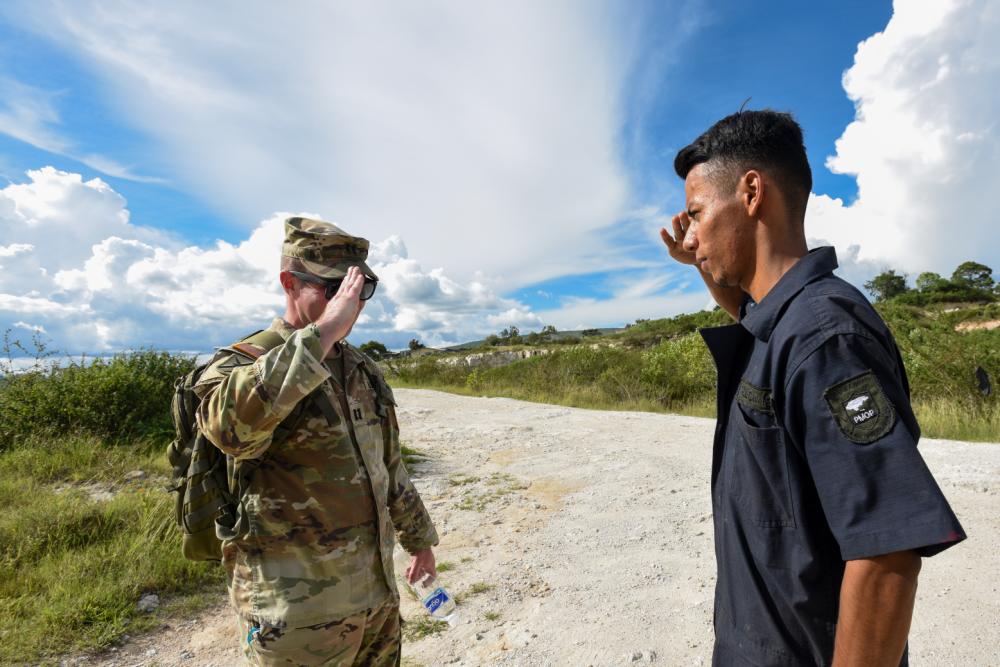 Capt. Madison Bips, a member of the Georgia National Guard's 1st Battalion of the 54th Security Force Assistance Brigade, returns a salute from a member of the Honduran Armed Forces, Sept. 8, near Tegucigalpa, Honduras. Bips was deployed to Honduras as part of the 54th SFAB's 6-month deployment to Honduras providing security force assistance, which was the first National Guard deployment of its kind. (Photo by Sgt. 1st Class Whitney Hughes)
Capt. Madison Bips, a member of the Georgia National Guard's 1st Battalion of the 54th Security Force Assistance Brigade, returns a salute from a member of the Honduran Armed Forces, Sept. 8, near Tegucigalpa, Honduras. Bips was deployed to Honduras as part of the 54th SFAB's 6-month deployment to Honduras providing security force assistance, which was the first National Guard deployment of its kind. (Photo by Sgt. 1st Class Whitney Hughes)
SOTO CANO AIR BASE, Honduras – The 54th Security Force Assistance Brigade recently made history as the first National Guard unit of its kind to activate and deploy in support of combatant command missions.
Activated in March of 2020, the 54th SFAB is headquartered in Indiana and has six battalions in Florida, Georgia, Illinois, Ohio, and Texas. While the five active component SFABs are directly aligned under combatant commands, such as United States Southern Command or United States European Command, the Army Guard SFAB is globally focused and capable of deploying Soldiers to support missions anywhere in the world.
Recently, members of the Georgia National Guard 1st Battalion, 54th SFAB, completed a deployment to Honduras, making them the first National Guard members to deploy as an SFAB.
“The whole intent of having a security force assistance brigade is to assist our partner nations and foreign security forces,” said Col. Jeff Hackett, who commanded the 54th SFAB from its activation until last year.
SFAB Personnel
In addition to the unique nature of the SFAB mission, its manning is also one of its defining characteristics. SFAB Soldiers are all volunteers, hand-selected from other units across all 54 states, territories, and the District of Columbia.
“The way the SFAB is set up is to try to get more mature individuals that already have their key leader development time,” said Sgt. 1st Class Dean DeAngelo, the senior battalion logistics noncommissioned officer, Georgia Army National Guard’s 1st Battalion, 54th SFAB. “The whole idea behind it is to be able to advise your partner forces two levels up from your current position.”
The brigade also differs from the traditional Army force structure in accomplishing its advising mission. The advisor teams are typically comprised of between four and 12 Soldiers and operate much more autonomously than conventional forces, based on their partner force needs.
These teams are broken down into:
● Maneuver advising Teams
● Field artillery advising team
● Engineer advising teams
● Logistics advising teams
The Selection Process
There are two ways soldiers can join an SFAB.
For immediate eligibility, Soldiers must be the rank of sergeant first class or above and have completed key and developmental positions, such as platoon sergeant for an infantryman. Upon completion of requirements, Soldiers are eligible to be selected through an interview with SFAB leadership.
Soldiers that do not meet these criteria must pass a rigorous five-day assessment and selection. The selection entails an Army Combat Fitness Test, a leader reaction course, team events, a warrior skills test, military occupational skill proficiency and ethical dilemma tests, a subject matter expert interview, and culminates with a ruck march.
“We are getting Soldiers that are senior leaders already, but not everybody is cut out for the SFAB,” said Lt. Col. Matthew Makaryk, commander of the 1-54th SFAB, adding that the success rate of the selection process is not high.
In Makaryk’s Battalion, the average enlisted advisor is 31 years old with 10 years of service and an associate degree. The average officer advisor is 36, with 13 years of service and a master’s degree. Most also have two to three years of deployment experience as well, said Capt. Madison Bips, the unit’s operations officer.
Specialized Training
The SFAB training cycle also differs from Army Guard’s traditional training schedule. Rather than attending training for the traditional one weekend a month and an annual training event, they train one week a fiscal quarter and attend an annual training event.
In addition to the yearly training, SFAB Soldiers are given specialized training opportunities. Soldiers assigned to advisor positions complete the 54-day Combat Advisor Training course at the Military Advisor Training Academy at Fort Benning, Georgia. On top of that, many SFAB members receive cultural and language familiarity training and training on foreign weapons, advanced medical training, driver training, and survival, evasion, resistance, and escape techniques.
In addition to their domestic training, SFAB Soldiers also participate in numerous foreign training exercises.
“What drew me to the SFAB was the opportunity to stand up a unit from the ground up in the Guard and being able to go on overseas training,” said DeAngelo. During his four years with the SFAB, he trained in Brazil as part of Exercise Southern Vanguard in 2021 and deployed to Honduras with the SFAB in 2022.
Now that he has surpassed the three-year mark as an SFAB member, he has reached the end of his time with the unit. But this is by design —the SFAB is structured to return its advisors to the force as more seasoned professionals.
“It’s time for me to move on and take my experience from the SFAB and take it back to the conventional force,” he said.